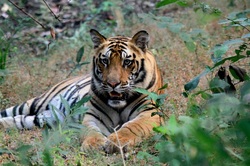My Story
..." To the native people, the land belongs to everybody. It could not be bought or sold anymore than water, air or sunlight...”
-Georgetta Stonefish Ryan
The “Sale” of Manhattan- Smithsonian, National Museum of the American Indians New York
-Georgetta Stonefish Ryan
The “Sale” of Manhattan- Smithsonian, National Museum of the American Indians New York
 Photo credit: Naresh Rao
Photo credit: Naresh Rao
These past few months I have spent some time reconnecting with nature, both through travel and through research. I have tried to better understand our diverse ecosystem; and have learned about individuals and organizations who are working towards wildlife conservation. Some stories have been heartwarming and others concerning. The common theme, that has evolved out of this exploration is that - the challenges facing wildlife conservation are not isolated to one country or continent, this is truly a global issue. Although I understood that in some context I could not fully appreciate the complexity of the issue on hand. After a few years of being away from communitywide outreach program related to conservation I feel compelled to reengage. What rekindled the quest for conservation in me? South Africa!
We had the wonderful opportunity to visit South Africa in 2014! The wonders of nature, specifically the incredible animals, truly reinvigorated me. Anyone who has ever been immersed in the mesmerizing energy of these magnificent beings knows what I am talking about. Unlike humans, animals are patient and equitable. They use only what they need and are willing to share with us this land. A quote from the Smithsonian, National Museum of the American Indians in New York has stayed with me since I first read it …" To the native people, the land belongs to everybody. It could not be bought or sold anymore than water, air or sunlight..." (Georgetta Stonefish Ryan. The "Sale" of Manhattan). Despite the silent messages the animals convey, and cultures that live in harmony with nature promote, we are not in sync with that philosophy of land sharing and coexisting. As you will read in the links and resources provided, loss of natural habitat, poaching, and human-animal conflict are the leading causes for population decline for any animal, whether on the endangered list or not. We humans, intentionally or unintentionally, are sadly the most invasive species of all. But that can change, and we can make a difference. That said, I realize that conservation is not a one-solution problem; it has many facets. It requires protecting animals, land stewardship, advocacy, working with local communities, political will, national and international wildlife policy, funding, law enforcement, and public awareness. Some or all of these measures need to be considered for the process to be successful. Through this website, I hope to highlight the highs and lows of wildlife conservation by promoting public awareness through education.
~ Ayesha Siraj
September, 2014
We had the wonderful opportunity to visit South Africa in 2014! The wonders of nature, specifically the incredible animals, truly reinvigorated me. Anyone who has ever been immersed in the mesmerizing energy of these magnificent beings knows what I am talking about. Unlike humans, animals are patient and equitable. They use only what they need and are willing to share with us this land. A quote from the Smithsonian, National Museum of the American Indians in New York has stayed with me since I first read it …" To the native people, the land belongs to everybody. It could not be bought or sold anymore than water, air or sunlight..." (Georgetta Stonefish Ryan. The "Sale" of Manhattan). Despite the silent messages the animals convey, and cultures that live in harmony with nature promote, we are not in sync with that philosophy of land sharing and coexisting. As you will read in the links and resources provided, loss of natural habitat, poaching, and human-animal conflict are the leading causes for population decline for any animal, whether on the endangered list or not. We humans, intentionally or unintentionally, are sadly the most invasive species of all. But that can change, and we can make a difference. That said, I realize that conservation is not a one-solution problem; it has many facets. It requires protecting animals, land stewardship, advocacy, working with local communities, political will, national and international wildlife policy, funding, law enforcement, and public awareness. Some or all of these measures need to be considered for the process to be successful. Through this website, I hope to highlight the highs and lows of wildlife conservation by promoting public awareness through education.
~ Ayesha Siraj
September, 2014